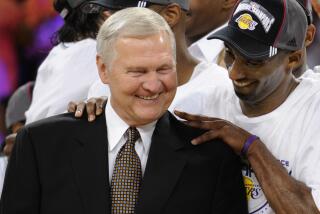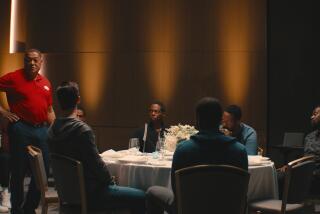In the NBA, It’s Not Enough to Stand Pat
- Share via
I could never figure out why Patrick Ewing has not taken over the game of basketball. I mean, I had seen this script before. Wilt Chamberlain came out of the ranks of the Harlem Globetrotters and into the NBA and, if it weren’t for Bill Russell, would have swallowed the game whole. How else would you classify 100 points in one night, a 50.4 average one season, more than 35,000 points lifetime including playoffs?
Then there was Kareem Abdul-Jabbar--45,000 points if you wanted to include playoffs, relatively modest nightly averages but such an intimidating factor the payoff was a virtual championship or near-miss.
There was Nate Thurmond, who had a havoc-wreaking career in the San Francisco pivot, Willis Reed in New York, Bob Lanier in Detroit and later, Milwaukee.
There were other great players, Walt Frazier, Oscar Robertson, Hal Greer, Guy Rodgers, Earl Monroe, but they seemed to be along for the ride.
They went and got the ball so the big guys could fire it into the baskets. They were like guys carrying ammunition to the battleship’s big guns.
So, the game was a simple proposition. Big man in the pivot, quick guard to bring the ball upcourt. Shoot and fall back.
Oh, they legislated against this game. They tried to stop the big guy camping in the middle for the easy layup. They put in the three-second rule, they outlawed the moving picks. But it was a big man’s game.
Patrick Ewing looked like six world championships to the New York Knicks when they won him in the league lottery. Big (7 feet), mobile, he could run, shoot, block, rebound. A new Goliath.
He turned out more a new Gulliver. Patrick Ewing has been with the Knicks nearly six years. But the championship games have people such as Isiah Thomas (6-1) and Joe Dumars (6-3) or Larry Bird (6-9) or Magic Johnson (6-9) in them.
Has the game changed? Well, you don’t go to the line after every foul any more, you don’t get three to make two, there’s something called a “loose ball” foul, which is an invitation to felonious assault, a license to swarm.
But what has really happened, in the view of Patrick Ewing, is that the basketball floors are crowded with superior athletes today--the pick of 10,000 playgrounds and high school gyms. Your Big Man in the Post doesn’t go cruising down the floor any more like the USS Missouri through a fleet of sampans. He can’t take the ball and dip it through basket after basket. He is harassed, hounded, harried. He is thrown out of his rhythm. The pros call it “trapping,” but it is really the basketball equivalent of gang-tackling.
It is on the whole a refreshing development. It makes it a five-man game instead of a one-man game. Twenty years ago, Patrick Ewing would have had to worry mainly on the nights he played Bill Russell or Wilt Chamberlain. The other games would have been complicated shoot-arounds. Today, he has 26 other teams to worry about.
A one-man team holds no terror for the league any more. In the old days Chamberlain would have been able to “turn in,” a basketball term for being able to just lean over the center guarding you and help yourself to easy two-pointers, over two-thirds of the centers in the league.
Today, the basketball strategists cope with the problem two ways. They either concede the league bully his 26 points a game (Patrick Ewing is averaging 26.7) and stop the rest of the team. Or, if they want to, they stop him, too.
Wilt Chamberlain probably scored more three-foot baskets than anyone. Patrick Ewing is rarely that close to the basket.
The New York Knicks are not to be confused with the Bob Cousy-Russell-K.C. Jones Celtics or even the Abdul-Jabbar-Magic Johnson Lakers.
But neither are they the Charlotte Hornets.
They played a determined Clipper team at the Sports Arena the other night and the Clippers’ task was clear. They set their own battlewagon, Benoit Benjamin, just as tall and 20 pounds heavier than Ewing, on the New York top gun.
Benoit did a career best. He huffed and puffed after Ewing like a bill collector. He pushed himself into Ewing’s face so often that he fouled out with almost a minute to play. He had done things to Ewing that would have gotten him arrested out on the street.
His leaving the game had as much to do as anything with the fact that the suddenly liberated Ewing was able to send the game into overtime by, in effect, turning in on Benoit’s successors and tying the game with a basket with seconds to go in regulation.
The interesting point is, none of the Clippers’ measures were able to stop Ewing from scoring 44 points. And those 44 points weren’t enough to win the game by anything but a one-point margin--in overtime.
It’s not as if Ewing isn’t a force. He scored 2,347 points last season, had a game high of 51, had 893 rebounds and 327 blocked shots.
But the team finished third. This year, Ewing is anchoring a team that is 19-24 and clinging to playoff hopes by its fingertips.
“You have to understand this league has better athletes than it has ever had or that it had in another era,” Ewing was explaining as he sat in the locker room after the game, knees encased in ice packs. “I am not taking anything away from the Chamberlains. I am sure Wilt would be a great player in any era. I am just not sure anybody can walk over the players we have out here today.
“I don’t feel I’m carrying this team on my back. I told them when I came over here, I wasn’t a savior. I was a key player, but it takes five today.”
It is considered a rule-of-thumb in pro football that, if a passer has to throw 50 or more passes, his team loses. In the declining years of his career, stung by criticism that his scoring highs did more for Chamberlain than the team, Wilt became more pass-off conscious, and his scoring average fell to 13.2. His point total dropped from 4,029 in 1962 to 1,084 in 1973.
Did Patrick Ewing feel a 40-point night was counter-productive? “I never set goals. My main goal is winning the championship. To do that, you find the open man. Sometimes, I’m the open man.”
His coach, John MacLeod, stood to one side. “The days of the big man doing it by himself are gone. You have to be able to kick the ball back out there. And, if you kick it back out to a Magic Johnson or a James Worthy or an Isiah Thomas, you’ll find yourself losing your crowd.”
If Patrick Ewing could lose his crowd on the court he would become one himself--and become what everyone expected he would be--the dominating force in the league and the logical successor to the court despots of the past.
More to Read
Go beyond the scoreboard
Get the latest on L.A.'s teams in the daily Sports Report newsletter.
You may occasionally receive promotional content from the Los Angeles Times.










